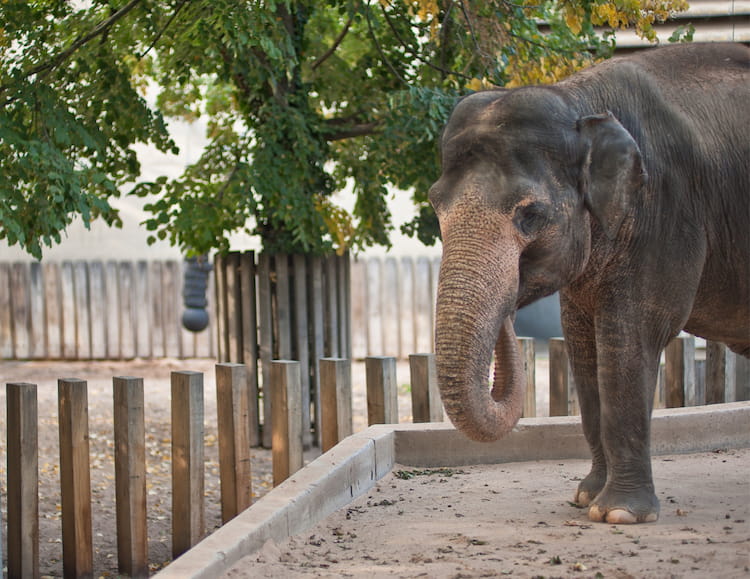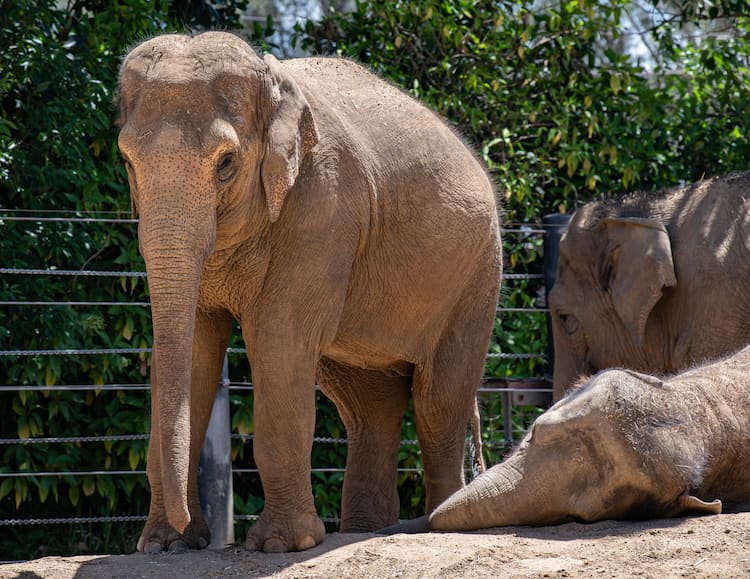Report Summary
In 2022, more than one thousand elephants are held captive around the world. In captivity, these enormous, complex, and sentient beings suffer immensely from debilitating mental and physical disease, great limitation of behavioral expression, restricted social opportunities, shortened lifespan, compromised fertility, and decreased birthing success.
Despite growing evidence confirming the high prevalence of these issues within captive populations, zoos around the world continue to house elephants in captive conditions that negatively impact their individual welfare and even counter-act wider species-level conservation.
To emphasize the urgency of addressing this issue, Born Free released a report, A Legacy of Shame, which outlines the historical and continuing plight of elephants in zoos across the United States, Canada, and Europe, using specific individual case studies to paint a harrowing picture of suffering.
We conclude that elephants do not belong in captivity, recommend that keeping elephants in zoos should ultimately be phased out, and demand that the capture of wild elephants for captive use and the breeding of elephants in zoos come to an immediate end. Should the statistics we provide to support our arguments fail to convince you of the urgency this ethical issue carries, details from the individual case studies likely will. These are their stories.
Dive deeper into animal welfare and ethics! Learn more about Animal Behaviour and Welfare with a course from the University Of Edinburgh

Case Studies
Artificial Insemination Torment: Chai
Captive elephant populations are not sustainable. Despite zoos claiming to help improve elephant conservation in the wild, the very same facilities actually deplete wild populations via international export from range states to replenish their elephant inventories due to the high infant mortality observed in captivity.
For the captive Asian elephant population alone, it was stated in 2000 that zoos in North America would need to import four elephants per year from the wild to maintain the population at the current level (Wiese, 2000). Since 2000, in North America and the U.K., deaths have consistently outnumbered births each year due to infant deaths associated with calf rejection, infanticide, and reproductive disorders among pregnant mothers, which remain exceedingly high compared to those observed in the wild (Hartley & Stanley, 2016).Chai, a 37-year-old Asian elephant who died at Oklahoma City Zoo in 2016, was subjected to more than 100 artificial insemination attempts throughout her lifetime. Keepers chained Chai with anchors fastened to each of her legs, which prevented her from moving. She would stand for long periods of time immobilized in this way, while a three-foot-long hose was inserted into her reproductive tract. Chai underwent mock inseminations for two years until the zoo received the first batch of elephant sperm. Then, the artificial insemination procedures were repeated ten times per month, sometimes twice per day, in attempts to inseminate Chai.

In 1998, she was moved to the Dickerson Park Zoo in Springfield, Missouri, to be bred to a bull, despite an outbreak of the virus Elephant Endotheliotropic Herpesvirus hemorrhagic disease (EEHV-HD) that had emerged there. EEHV-HD is considered the primary cause of calf mortality in the global captive Asian elephant population (Jesus et al., 2021).[1] In November of 2000, Chai gave birth to a female calf named Hansa. Hansa died at just seven years old—from EEHV-HD.
In January 2016, Chai was found dead in her yard. A post-mortem revealed that Chai had died from a combination of systemic blood infection and severe fat loss. Oklahoma City Zoo reportedly suspected that the infection was a result of pus-filled lesions on the side of her body, possibly sustained during an episode in which she was unable to stand and had to be raised using a hoist.
Oklahoma City Zoo’s medical records showed that Chai had suffered injuries, weight loss, skin lesions, chewing problems (likely because of deformed teeth), and other incidents in the months before her death.Unjustified Wild Capture: Mlilo
Mlilo was born at Hlane National Park, Eswatini, where she lived with her wild herd for approximately 15 years before being captured and loaded, along with five other elephants, onto a 20-hour flight to Dallas Zoo in 2016.
Mlilo was one of 17 wild elephants, aged between six and 25, captured in Eswatini and sent to three U.S. zoos (Dallas Zoo in Texas, Sedgwick County Zoo in Kansas, and Henry Doorly Zoo in Omaha, Nebraska). Zoo officials described the import as a “rescue mission” from drought conditions. The export was met with international outrage and fierce objections, including from 80 of the world’s top elephant scientists and conservationists, with legal challenges launched to try and halt the plans.
Mlilo was pregnant (and had therefore been transported in contravention of International Air Transport Association guidelines). She gave birth to baby Ajabu just two months after she arrived at the zoo. As Mlilo’s calf Ajabu is a male, he will be separated from his mother in the coming years to avoid inbreeding. Whether this will involve him or any of the other elephants being relocated to another zoo remains to be seen.

Eswatini National Trust Commission officials reportedly claimed that there was ample space and food in other reserves in the country that could have provided an alternative solution for these elephants, but that they were never consulted.
The 2016 export was almost identical to that of 11 elephants sent from Eswatini to two U.S. zoos (Lowry Park Zoo in Tampa, Florida and San Diego Wild Animal Park in California) in 2003. These juvenile elephants were taken from wild herds in Hlane National Park and Mkhaya Game Reserve, reportedly to help ease overpopulation there and to rescue them from being killed. However, statements from San Diego Wild Animal Park following the elephants’ arrival also claimed that their import was necessary to revive captive breeding efforts, due to an aging zoo population in the U.S.
Apparently, zoos paid 133,000 USD to the Eswatini Parks, which was supposed to be put towards its improved management of their wild population to prevent the need for other elephants to be captured in the future. Sadly, for Mlilo and her cohorts, further captures and exports were clearly not prevented.
Threat to Public Safety, Now Living in Solitude: Suki
Holding elephants captive not only puts the elephants themselves at risk of a multitude of potentially life-threatening issues, but also jeopardizes the safety of the people responsible for handling and caring for them and even zoo visitors. Regardless of the level of animal husbandry training zookeepers receive, no amount of preparation can guarantee the prevention of a dangerous elephant incident, attack, or escape.
Elephants are responsible for more keeper deaths than any other captive animal. Despite the clear dangers involved with coming into unprotected contact with elephants, several zoos still practice “open contact” management, in which keepers occupy the same space as elephants without a barrier between them, and offer visitors the chance to pose with elephants for photos or even sit on their backs.
Suki was born in the wild in 1964 and imported, via a private dealer, to Detroit Zoo in 1965. After being transferred between five zoos and two circuses throughout the 1960s, 1970s, and 1980s, she ended up at Dickerson Park Zoo in 1987, where she stayed for almost nine years.
News reports confirm that Suki attacked a keeper at Dickerson Park Zoo, “throwing him against a wall and trying to stomp on him,” and may even have killed people at some point in the past. Several circus trainers had reportedly also deemed her to be “unmanageable.”
In 1996, Suki was moved to Point Defiance Zoo in Washington, where she lives today as the zoo’s only elephant. Suki has been characterized as aggressive towards both keepers and other elephants. Unfortunately, she has been diagnosed with uterine tumors and in 2019, tested positive for tuberculosis.
Conclusion
In 2022, estimates suggest that 299 elephants live at 67 North American zoos: 162 African, 137 Asian; plus at least an additional 93 in circuses, private collections, and sanctuaries, which are not required to publicize their animal inventories.
The zoo environment cannot possibly provide elephants with the space or complexity of habitat they require, nor can it enable the complex social groupings and bonds to develop that are clearly so important to normal elephant society.
The average Asian elephant’s home range size in the wild is 8401.58-246,364 acres, with a herd size of seven to 10 individuals, and a lifespan of over 70 years. In captivity, elephants are confined to an average enclosure size of 1.98 acres, have a herd size of three individuals, and live to a median age of 20 years old. Therefore, continuing to keep elephants in zoos, primarily for the purpose of public entertainment, cannot be justified.
Seen in this light, the physical, psychological, and behavioral pathologies and abnormalities so frequently observed in captive elephants are hardly surprising. Even some within the zoo community have acknowledged this uphill battle by ending their elephant programs. We advise all zoos to do the same, in efforts to finally make a real difference for the future of elephants; one that they so desperately deserve and need.
Article by: Devan Schowe for Born Free USA


